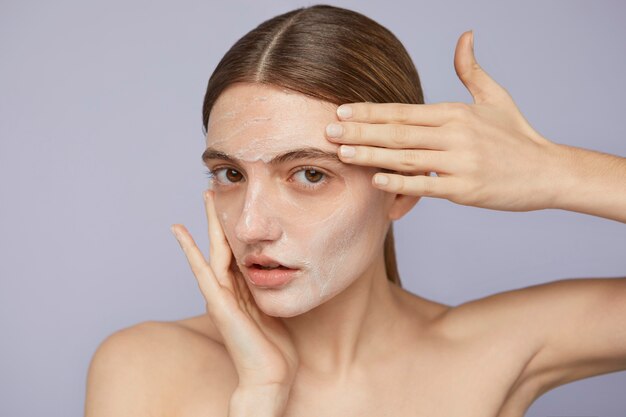Melasma Treatment: A Guide for Every Skin Tone

Strong 8k brings an ultra-HD IPTV experience to your living room and your pocket.
Melasma, characterized by dark, irregular patches of skin, is a common pigmentation disorder that affects individuals across various skin tones. While it primarily appears on the face, particularly on the cheeks, forehead, nose, and upper lip, the approach to treating melasma can differ based on skin tone. This guide provides an overview of effective Melasma Treatment in Dubai tailored for different skin tones, ensuring that individuals receive appropriate care for their specific needs.
Understanding Melasma:
Melasma is a type of hyperpigmentation that results from an overproduction of melanin, the pigment responsible for skin color. It is influenced by several factors, including:
Sun Exposure: Ultraviolet (UV) rays stimulate melanin production, leading to darker patches.
Hormonal Changes: Pregnancy, birth control pills, and hormone therapy can trigger melasma.
Genetics: A family history of melasma can increase susceptibility.
Heat and Inflammation: Excessive heat or inflammation from skin conditions can exacerbate melasma.
Given its varying appearance and causes, treatment must be personalized based on skin tone to effectively manage and reduce pigmentation.
Melasma Treatment for Light Skin Tones:
For individuals with light skin tones, treatments typically focus on reducing pigmentation while ensuring minimal risk of adverse effects. Here are some effective options:
Hydroquinone
Hydroquinone is a widely used skin-lightening agent that works by inhibiting melanin production. It is available in both over-the-counter (2%) and prescription (4%) formulations. For light skin tones, hydroquinone can be highly effective in lightening melasma patches. However, it should be used under the guidance of a dermatologist to avoid potential side effects such as ochronosis, where prolonged use leads to a darkening of the skin.
Tretinoin
Tretinoin, a retinoid, helps to increase cell turnover and exfoliate pigmented skin. It promotes the shedding of old skin cells and encourages the growth of new, healthier skin. Tretinoin is often used in combination with hydroquinone in what is known as "triple therapy" to enhance results. Users may experience initial irritation, redness, and peeling, which can be managed by starting with a lower concentration.
Chemical Peels
Chemical peels, including glycolic acid and trichloroacetic acid (TCA), are effective for light skin tones. These peels exfoliate the top layer of skin, reducing pigmentation and promoting new skin growth. Light to medium peels are suitable for treating melasma on lighter skin tones, while deeper peels should be approached cautiously to avoid potential complications.
Laser Therapy
Lasers such as fractional lasers and Q-switched Nd
lasers can target pigment in the skin and break it down. These treatments are effective for light skin tones, where the risk of post-inflammatory hyperpigmentation (PIH) is lower. Multiple sessions may be required to achieve optimal results.
Niacinamide
Niacinamide, or vitamin B3, is a gentle, effective option for light skin tones. It reduces melanin transfer and has anti-inflammatory properties that can soothe irritated skin. Niacinamide is suitable for long-term use and can be combined with other treatments for enhanced results.
Melasma Treatment for Medium Skin Tones:
Medium skin tones require treatments that address pigmentation while minimizing the risk of hypopigmentation or discoloration. Here are some tailored options:
Azelaic Acid
Azelaic acid is a dicarboxylic acid that helps reduce pigmentation and improve skin texture. It inhibits tyrosinase, the enzyme responsible for melanin production, and has anti-inflammatory properties. Azelaic acid is suitable for medium skin tones and can be used alone or in combination with other treatments.
Tranexamic Acid
Tranexamic acid, available both topically and orally, has shown effectiveness in treating melasma. It works by reducing melanin production and improving skin tone. Oral tranexamic acid requires careful monitoring for potential side effects, while topical formulations can be used more frequently.
Microneedling with PRP
Microneedling involves creating micro-injuries in the skin to stimulate collagen production and enhance skin texture. When combined with platelet-rich plasma (PRP), which contains growth factors from the patient’s blood, it can improve melasma by accelerating skin healing and reducing pigmentation.
Kojic Acid
Kojic acid, derived from fungi, helps lighten skin by inhibiting melanin production. It is often used in combination with other lightening agents and can be effective for medium skin tones. Kojic acid is generally well-tolerated but may cause irritation in some individuals.
Melasma Treatment for Dark Skin Tones:
For dark skin tones, treatment strategies must carefully consider the risk of exacerbating pigmentation or causing post-inflammatory hyperpigmentation (PIH). Here are some effective options:
Hydroquinone with Caution
Hydroquinone can be effective for dark skin tones but must be used with caution. Prolonged use or higher concentrations can lead to PIH. A dermatologist can help determine the appropriate strength and duration of use to minimize risks.
Combination Therapies
Combination therapies involving hydroquinone, tretinoin, and corticosteroids can be effective for dark skin tones. These combinations help reduce pigmentation while minimizing inflammation and irritation. However, it’s crucial to use these treatments under dermatological supervision.
Laser Treatments
Lasers such as the Nd
laser and PicoSure laser can be used for dark skin tones. These lasers penetrate deeper into the skin and target melanin without affecting the surrounding tissues. Careful selection of laser types and settings is essential to avoid PIH.
Microneedling
Microneedling can be effective for dark skin tones when performed by experienced professionals. It stimulates collagen production and improves skin texture without significant risk of PIH, especially when combined with PRP.
Sun Protection
For dark skin tones, sun protection is critical in managing melasma. Use broad-spectrum sunscreens with SPF 30 or higher, and reapply regularly, especially if exposed to sunlight. Sun protection helps prevent melasma from worsening and supports the effectiveness of other treatments.
General Tips for Managing Melasma Across All Skin Tones:
Regardless of skin tone, certain general tips can help manage melasma more effectively:
Consult a Dermatologist: A dermatologist can provide personalized treatment plans based on skin tone and type.
Follow a Consistent Skincare Routine: Regular use of prescribed treatments and adherence to a skincare routine is essential for managing melasma.
Avoid Excessive Sun Exposure: Protect your skin from the sun to prevent melasma from worsening.
Stay Hydrated and Maintain a Healthy Diet: Proper hydration and nutrition support overall skin health.
Conclusion!
Treating melasma requires a tailored approach that considers skin tone, type, and specific needs. In Dubai, where sun exposure is intense, it is essential to combine effective treatments with rigorous sun protection. Whether you have light, medium, or dark skin tones, various treatments can help manage and reduce melasma, improving skin appearance and boosting confidence. Consulting with a dermatologist and adhering to a comprehensive treatment plan can lead to the best outcomes in managing this challenging condition.
Note: IndiBlogHub features both user-submitted and editorial content. We do not verify third-party contributions. Read our Disclaimer and Privacy Policyfor details.



